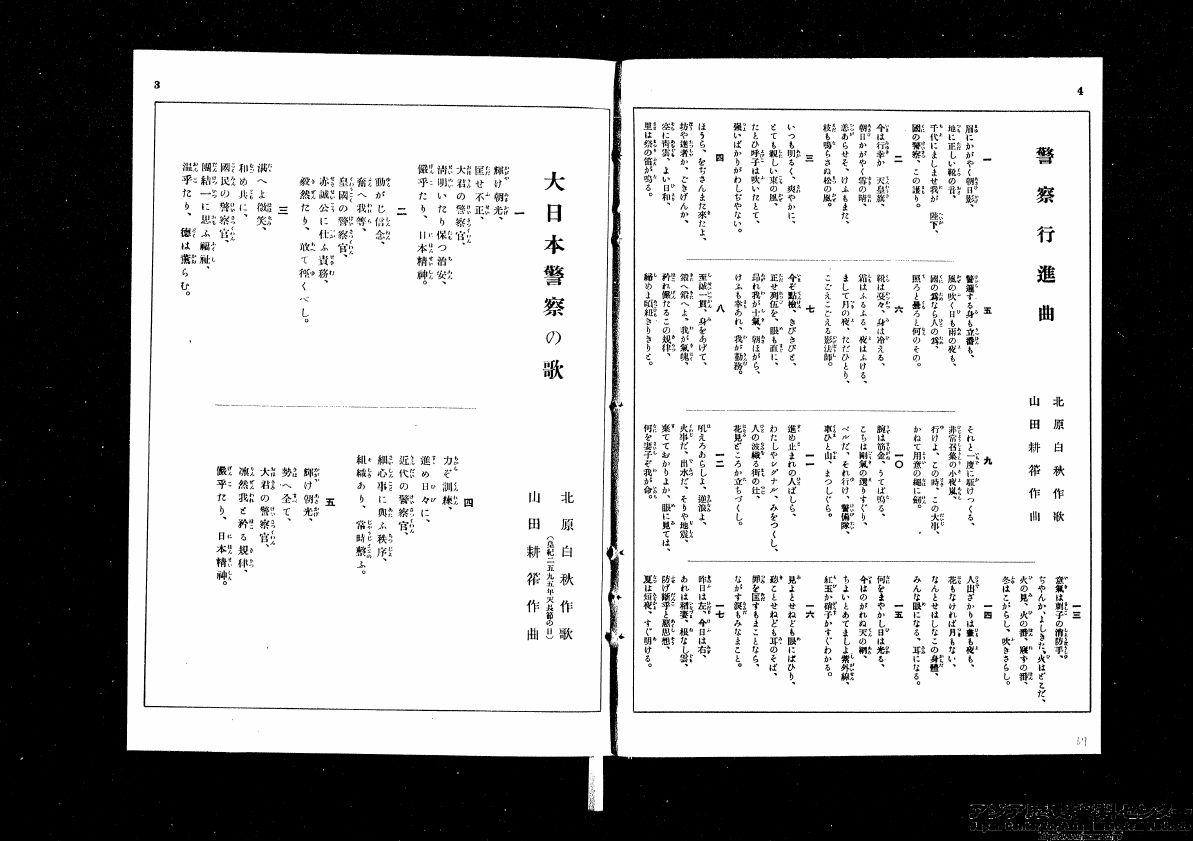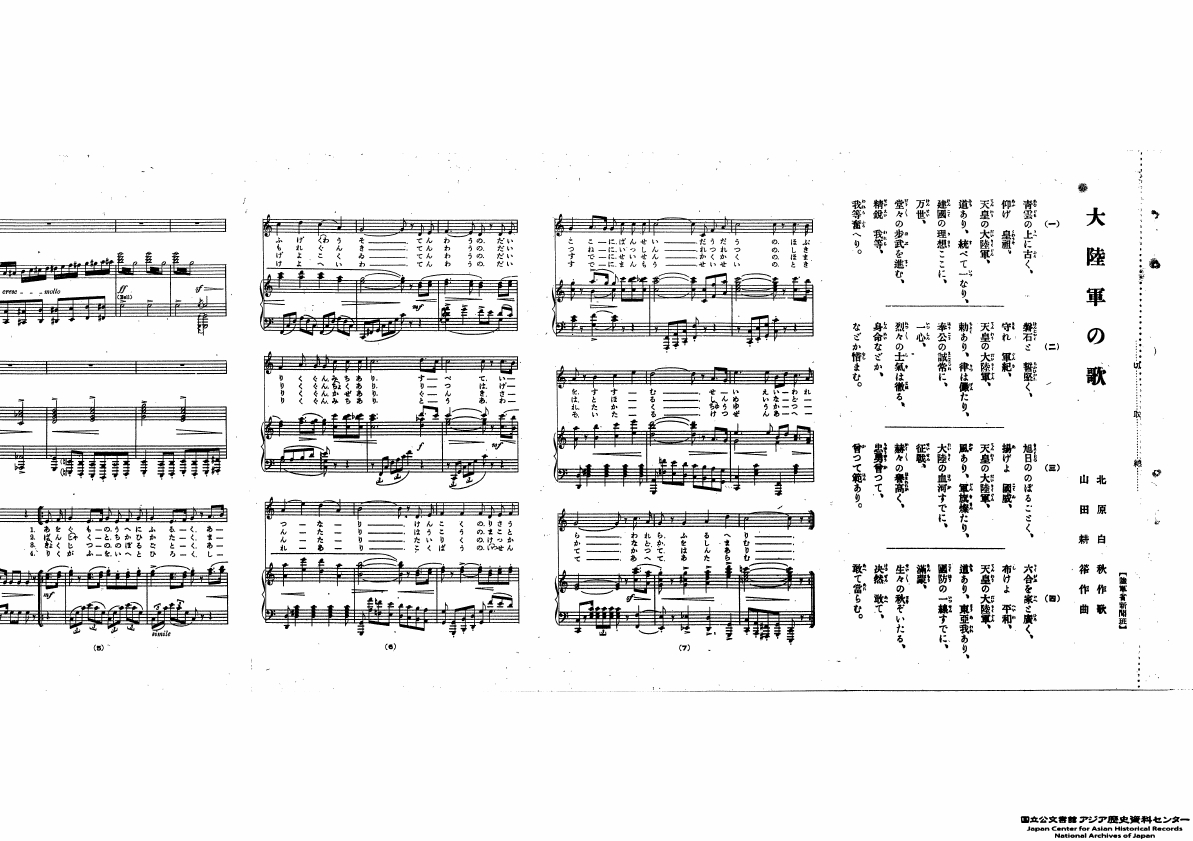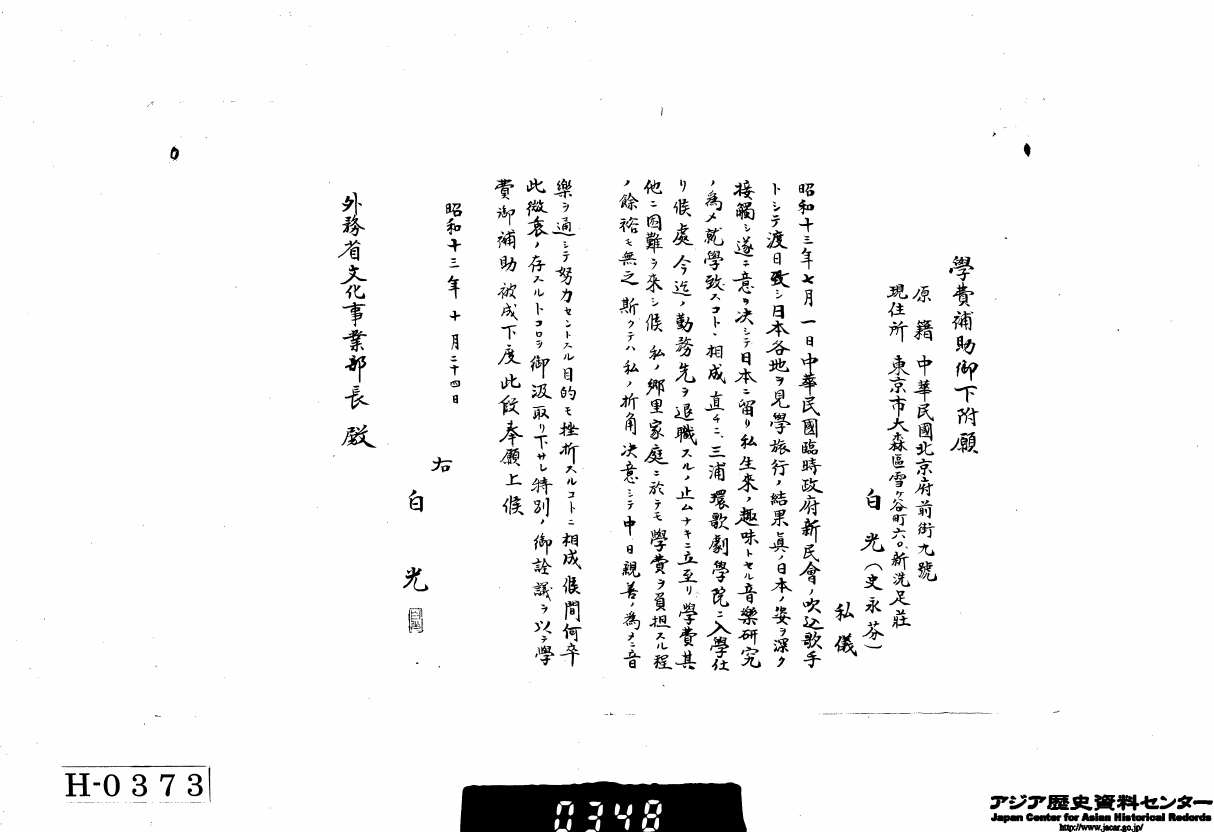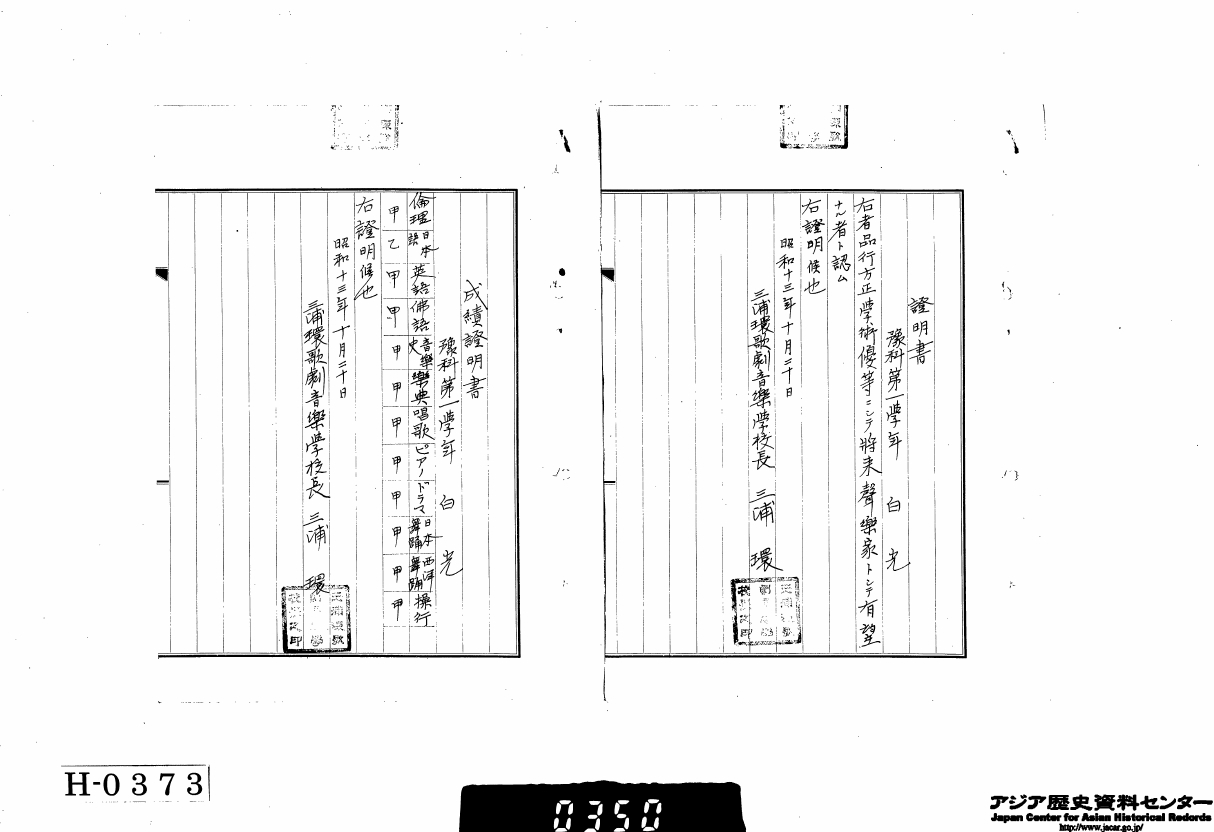

-The Institute for Economic and Business Research Shiga University>The Ishida Memorial Collection
-Archives of Hokkaido>Document of the Colonization Commission exchanged between Council of State
-Kobe University Library> Documents on the Opening of the Port of Kobe
2. Documents Spotlight
-The Ninth and a Japanese POW Camp for German Soldiers: Nearing the Centennial of the First Performance
of Beethoven’s Symphony No. 9 in Japan (Ryo Nakano, Researcher, JACAR)
-Musicians Who Can Be Encountered in JACAR Documents (Akiko Matsuura, Researcher, JACAR)
3. Outreach Activities
4. Event Informations on the Related Organs
-National Archives of Japan
-Diplomatic Archives of the Ministry of Foreign Affairs
The Institute for Economic and Business Research Shiga University>The Ishida Memorial Collection
Archives of Hokkaido>Document of the Colonization Commission exchanged between Council of State
Kobe University Library> Documents on the Opening of the Port of Kobe
In Japan, performances of Beethoven’s Ninth Symphony have become a regular annual end-of-year event, with many orchestras around the country featuring the work on their schedules as December draws to a close. The year 2018 will mark the centennial of the first performance in Japan of the Ninth--formally, Symphony No. 9 in D minor, Op. 125--a piece that is now much-loved among the Japanese people. That performance took place on June 1, 1918, in a prisoner-of-war (POW) camp for German soldiers located in what was then Bandō Town (now a part of Naruto City), Tokushima Prefecture.
*Of interest to those who read Japanese, in the modern era a prisoner of war was referred to using the word furyo俘虜 in contrast to the word horyo捕虜 used conventionally today. The term furyo appears in many documents made available through JACAR, and that usage is retained throughout the original Japanese version of the present article.
When World War I began in July 1914, on the basis of the Anglo-Japanese Alliance Japan entered the conflict as a member of the allied countries led by the U.K., France, and Russia. Japan’s army attacked Qingdao and other strategic locations on the Shandong Peninsula in China that one of the enemy powers, Germany, had leased. In the process, they took many soldiers and military personnel from Germany and its ally the Austro-Hungarian Empire as prisoners. Japan set up POW camps around Japan to confine them and created a Prisoner of War Information Bureau (Furyo jōhōkyoku) under the Minister of the Army to liaise with the International Red Cross. The Ministry of Foreign Affairs also handled negotiations with the relevant foreign governments regarding such matters as the treatment of POWs through its diplomatic missions abroad.
By the end of 1914 just after it had occupied Qingdao, Japan had established 12 POW camps around the country. They were located in Tokyo (subsequently moved to Narashino), Shizuoka, Ōita, Matsuyama, Marugame, Tokushima, Kurume, Kumamoto, Osaka (subsequently moved to Ninoshima, Hiroshima Prefecture), Nagoya, and Fukuoka. The camps thereafter gradually went through a series of reorganizations and amalgamations, with the result that by the time they were finally closed in 1920 after peace had been concluded only six remained (in Narashino, Bandō, Kurume, Ninoshima, Aonohara, and Nagoya).
Starting in the Meiji period, Japan felt pressured by the need to demonstrate itself to be a “civilized country” in order to establish diplomatic relations that were modern and equal. As part of that diplomatic policy, the government worked hard to comply with provisions laid down in the Convention Respecting the Laws and Customs of War on Land (the Hague Convention on Land Warfare of 1899) that the great powers of the West had set down as the norms for the conduct of war. (*The original signed copy of the ratified Hague Convention can be seen at ref. A03020484400.)The Convention includes provisions regarding the humane treatment of POWs, and policies were established to comply with them at the POW camps set up during World War I. Consequently, with a few extraordinary exceptions POWs on the whole were treated humanely.
Generally speaking, the people who heard these concerts were the prisoners being held in the camps. However, the concerts held at some of these camps were also open to the general public. The first such performance of the Ninth (albeit of only the first three movements) for Japanese listeners was given by the orchestra at the Kurume POW camp.
Incidentally, in January 1924 the Kyūshū Imperial University Philharmonic (now the Kyūshū University Philharmonic) became the first Japanese to feature the Ninth (the fourth movement only) in concert. The first complete performance of the symphony by Japanese musicians came that November in a concert at the Tokyo Music School (a predecessor to today’s Tokyo University of the Arts).
Music was not the only avenue for POWs to interact with Japanese. For example, soccer brought abundant opportunities for contact. At the camps in Nagoya and Ninoshima, for example, POW teams were pitted against sides from local junior high and normal schools and the German players are said to have passed on their superior soccer skills to the student athletes.
The commander of the Bandō POW camp where the Ninth received its first Japan performance was named Matsue Toyohisa (1872-1956) (see Image 3). Known for his particularly humane treatment of the prisoners in his charge, Matsue was the son of a warrior from the Aizu domain--one of the parties defeated during the Boshin War (1868-1869). He would later go on serve as mayor of Aizu Wakamatsu City. The camps at Tokyo and Narashino were both commanded by Saigō Toratarō (1866-1919). Saigō, who died from illness while serving in that capacity, was the eldest son of the famed Saigō Takamori, who died on the losing side in the Satsuma Rebellion. In thinking about how the German POWs were dealt with, it is thus deeply interesting to consider that individuals such as these who during the final years the Tokugawa shogunate and first ones of the new regime had themselves experienced defeat in wars were among those who ran the POWs camps.
As one part of the humane treatment afforded the POWs in the camp, there also arose an effort to have them work for pay at a variety of companies. Because German technological capabilities in a variety of fields were higher than those of Japan at the time, it was decided to try to put the technical skills of these POWs to use at business activities (see Image 4). Even after the camps were closed, some POWs chose to remain to live in Japan and passed on their knowledge of German technology and culture to the Japanese community. It is owing to their presence that various German foods--such baumkuchen and other such desserts, as well as German variations of sausages, roast ham, and bread--are still deeply familiar to Japanese today, and why the industrial technologies for rubber and other products established themselves in this country.
As the foregoing indicates, Japanese policy on prisoners of war had been known for the humane treatment afforded to its captives. However, as Japan increasingly isolated itself internationally in the 1930s, its interest in abiding by international treaties grew weak. Particularly during the Pacific War, the cruel treatment dished out to soldiers of the Allied Powers who were taken prisoner became a major issue. Assigning responsibility for this behavior was a matter of persistent questioning in the trials for Class B and Class C war crimes after the conflict’s end.
Thus, hidden behind the tale of the first performance in Japan of Beethoven’s Symphony No. 9 lies this history of the country’s policy on prisoners of war. This is something to keep in mind the next time you attend an end-of-year performance of the Ninth.
The Japan Center for Asian Historial Resources has made available public documents regarded the prisoner of war camps established during World War I. These documents come from the Diplomatic Archives of the Ministry of Foreign Affairs and the Center for Military History at the Ministry of Defense’s National Institute for Defense Studies.
(See here for registers related to German POWs held at the MOFA Diplomatic Archives)
(See here for registers related to German POWs held by NIDS)
(See here for a list of materials related to German POWs in the “欧受大日記” held by NIDS)
*Furthermore, a number of other documents can be found with a keyword search by using “俘虜” or “捕虜” as the search string.
Reference Materials
Tomita Hiroshi, Bandō furyo shūyōjo [The Bandō prisoner-of-war camp] (Hosei University Press, 1991).
Narashino City Board of Education, ed., Doitsu heishi no mita Nippon [The Japan that German soldiers saw] (Maruzen Books, 2001).
Yokota Shūichirō, Dai-Ku “Hajimete” monogatari [The tale of the Ninth’s “beginning”] (Sakuhokusha, 2002).
Utsumi Aiko, Nihongun no horyo seisaku [The prisoner-of-war policies of the Japanese army] (Aoki Shoten Publishing, 2005).
Seto Takehiko, Chintao kara kita heishitachi [The soldiers who came from Qingdao] (Dōgakusha, 2006).
Ōtsuru Atsushi, Fujiwara Tatsuo, and Fukushima Yukihiko, Aonogahara furyo shūyōjo no sekai [The world of the Aonogahara prisoner-of-war camp] (Yamakawa Shuppansha, 2007).
Beethoven-Haus (Bonn), ed., “Dai-ku” to Nihon: Deai no rekishi (Sairyusha, 2011), trans. of Die Macht der Musik: Das kulturelle Leben im deutschen Kriegsgefan genenlager Bando in Japan 1917-1919 [The power of music: Cultural life in the German prisoner-of-war camp Bando in Japan between 1917 and 1919] (Beethoven-Haus, 2009).
During the Meiji period, one of the goals the Japanese government set for itself was to revise various unequal treaties that had been signed with the countries of the West. To build the equitable diplomatic ties its sought, the government promoted policies aimed at westernizing Japan. One of the policies was to introduce western music to the country. These policies were given concrete form in 1879 when the Ongaku Torishirabegakari (Music Investigation Committee) was created within the Ministry of Education.
JACAR has among its materials a document titled “Ongaku torishirabe seiseki shinpōsho” [Report on the result of the investigation concerning music] (Ref.A07062217800). The Torishirabegakari’s director Isawa Shūji submitted the document in 1884 to Education Minister Ōki Takatō. The report covers the committee’s activities over the previous four years. It notes that the Torishirabegakari had set down three broad principles for itself in “Ongaku torishirabe ni tsuki mikomisho” [Prospects regarding the investigation concerning music], which it had submitted in 1879. One of these principles was “to nurture the persons who will establish the nation’s music (kokugaku) of the future.” Accordingly, to train specialists in Western and Japanese music in 1880 the Torishirabegakari allowed 22 individuals to enroll as special students (denshūsei) in music. They were taught singing, piano, and so forth. In 1883, the Torishirabegakari enacted new “Regulations for the Ministry of Education’s Ongaku Torishirabegakari” and created a four-year curriculum (see Image 1).
In 1887, the Ongaku Torishirabe was rechristened and relaunched as the Tokyo Music School. This new institution would go on to produce musicians whose names remain well-known even today. One may wonder, then, who exactly were the people involved with these two institutions--both among the instructors and the graduates--and what exactly did they do in the world of music. Using materials from the JACAR files, we can answer such questions.
The American music educator Luther Whiting Mason played a crucial role as an instructor during the Torishirabegakari’s early years. In 1882, his term of employment came to an end and his position was taken over a German, Franz Eckert. Prior to this, Eckert had been employed as an instructor in martial music by the Ministry of the Navy. As a consequence, the Defense Ministry’s National Institute of Defense Studies today still has a large number of materials related to him in its collection. These include, for example, the contract covering Eckert’s employment at the Navy Ministry (Ref. C09101868800, images 7 through 14) and a document relating the back and forth over seeing whether Eckert would teach harmonics and orchestral music at the Torishirabegakari as well (Ref. C09103590000). Eckert is also known for composing in 1880 the harmony for Kimigayo, Japan’s national anthem; the score for this is likewise viewable here (see Image 2).
Noted musician Kōda Nobu was among the first group of students to study under these music professors. The younger sister of equally noted writer Kōda Rohan, Kōda graduated from the Torishirabegakari in 1885. She then went on to study music overseas in Boston and Vienna before returning to become a professor and train numerous future musicians at the Tokyo Music School.
Among Kōda’s students was the future composer and conductor Yamada Kōsaku, best-known in Japan perhaps for composing the popular children’s song in the modern, dōyō style, “Akatonbo” [Red dragonfly]. Yamada graduated from the school’s voice faculty in 1908 and would go on to collaborate with poet Kitahara Hakushū on numerous works of music. Several examples of martial music (gunka) the pair took part in creating can be found through the JACAR archives, including “The Song of the Great Japan Police” and “The Police March” (Image 3) as well as “The Song of the Army” (Image 4).
Another of Kōda’s students (who herself would also go on to instruct Yamada) was the opera singer Miura Tamaki. Miura graduated from the voice faculty in 1904 and became first an adjunct instructor and then an assistant professor at the School. She achieved international fame in 1915 at the London Opera House when she became the first Japanese prima donna to sing the part of Cio-Cio-San in Puccini’s opera Madama Butterfly. JACAR’s catalogue includes a photo of Miura singing at a treatment facility for Hansen’s disease patients in a document published in 1940 (Ref. A17110111800, image 160).
Some rare items illustrating the connection between Miura and a certain foreign student who had come from Beijing can also be found today at the Diplomatic Archives of the Foreign Ministry. That student’s name was Shi Yongfen, better known by her stage name of Bai Guang (“White Light”). Bai came to Japan to study voice at Miura’s academy for opera singing. She made her film debut as one of the leads in “Tōyō heiwa no michi” [The road to peace in the Orient] (1938), a Tōwa Shōji Eiga-bu production involving both Japanese and Chinese filmmakers and crew (see Ref. B05016228900, images 2 through 12). Around this time, Bai Guang submitted an application addressed to the head of the Foreign Ministry’s Cultural Affairs Section for a scholarship, and Miura in her role as academy director provided a testimonial (see Image 5). Furthermore, in 1939 we can see that Bai enrolled as a special-course student in the Tokyo Music School and applied to continue receiving the scholarship (Ref. B05015504400).
Upon completing her studies, Bai Guang in 1942 went to Shanghai where she was active as an actress and singer. Her rich, low singing voice and Western singing style unusual for the time created a stir, and she came to be counted among a group of Chinese singers of the 1940s (such as Li Xianglan, “the Judy Garland of Japan”) known collectively as the Seven Great Singing Stars (Ch. “Qi da gexing”). In 1949, she went to Hong Kong. There, her performance in “A Strange Woman” (Ch. “Yi dai yaoji”)--a film-reworking of the Puccini opera Tosca--attracted attention, and she became synonymous with the part.
That same year, the Tokyo Music School was converted into the Department of Music for the newly created Tokyo University of the Arts (as it is known today). This institution still graduates numerous musicians every year even today. Anyone wishing to know more about the predecessors of these more recent graduates and their music such as we have seen above may find it profitable to look for information in the JACAR collection.
Works Consulted
Gotō Nobuko, Yamada Kōsaku: Tsukuru no de wa naku umu [Yamada Kōsaku: Not making, but bringing forth], Minerva shobō, 2014.
Hirataka Noriko, “Kōda Nobu no Bosuton ryugaku” [Kōda Nobu’s study-abroad experience in Boston], Ronsō [Essays], no. 54, 2013.
Nakamura Rihei, Yōgaku dōnyūsha no kiseki: Nihon kindai yōgakushi josetsu [On the trail of the people who introduced Western music: An introduction to the history of modern Western music in Japan], Tōsui shobō, 1993.
Tanabe Hisayuki, Kōshō Miura Tamaki [Madame Miura Tamaki], Kindaibungesha, 1995.
Wang Yong and Bao Jing, “A Voice of a Different Sort, ‘A Strange Woman’: Bai Guang” (in Chinese), Yinyue
aihaozhe--Music Lover, no. 2, 2007.
Yau Shuk-ting, Honkon-Nihon eiga kōryūshi: Ajia eiga nettowāku no rūtsu [A history of interchanges between the Japanese and Hong Kong film industries: An exploration into the roots of Asian film networks], University of Tokyo Press, 2007.
Yoshida Takashi, Gōmo kotonaru tokoro nashi: Isawa Shūji no onritsuron [No spots of deviation whatsover: The rhythm theories of Isawa Shūji], K. G. University Press, 2011.
-Domestic
|
June 12
|
Held demonstration in Special Seminar at Kindai University.
|
|
June 20
|
Held presentation at University of Tokyo database training courses of GACoS (Gateway to Academic Contents System)
|
|
June 22
|
Held presentation at University of Tokyo database training courses of GACoS (Gateway to Academic Contents System)
|
-Visitors
|
May 24
|
Ms. Kaoru Ueda(Stanford University, Hoover Institution, Curator of the Japanese Diaspora Collection)
|
|
Period
|
Event
|
About
|
Link
|
|
From July 21 to September 1, 2018
|
2018 2nd Featured Exhibition “The Tale of the Heike: Mysterious and Beautiful”
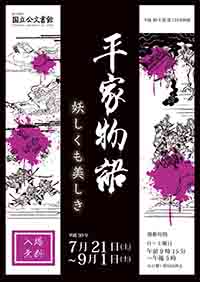 →PDF (1.5MB) |
Taira no Kiyomori was a warrior who rose to the position of chief minister of government (daijō-daijin) and established samurai-led rule in Japan. The year 2018 marks the 900th anniversary of his birth. Accordingly, the special featured exhibition to be held this summer will take up The Tale of the Heike (Heike monogatari), a classic literary text that depicts the lives of the people from Kiyomori at the height of his glory to the downfall of the entire Taira clan (i.e. the Heike).
On the other hand, alongside the many famous episodes that regularly appear in Japanese textbooks, The Tale of the Heike also contains numerous anecdotes and asides that are peculiar and mysterious. This exhibition relies on rare manuscripts and prints in the Archives’ collection to focus on scary stories appropriate to the heart of summer--a season when Japanese particularly enjoy tales of the supernatural. Step into the uncanny world of Heike where vengeful ghosts and goblins (tengu) work in secret behind the scenes.
|
|
|
Period
|
Event
|
About
|
Link
|
|
June 12 to October 11, 2018
|
Exhibition Commemorating the 150th Anniversary of the Meiji Restoration: Japanese Diplomacy in the Meiji Era as Reflected in Treaties.
|
The year 2018 marks the 150th Anniversary of the Meiji Restoration in 1868. This exhibition displays Treaties preserved in the Diplomatic Archives of the Ministry of Foreign Affairs of Japan to trace the story of Japanese diplomacy during the Meiji Era.
|
|
[Postscript]
Please email us if you would be interested in a member of JACAR presenting at your organization about our institution and its resources. We go to schools, research conferences, and a range of other institutions.
Leaflets about JACAR are available in English, Japanese, Chinese, and Korean, so if you would like copies, please contact us.
An email about the JACAR Newsletter has been sent to everyone who requested a copy as well as those who have exchanged business cards with JACAR staff members. If you do not wish to receive future e-mails, please let us know.
[Reference] TEL : +81-(0)3-5805-8801 E-MAIL : jacar_enquire@archives.go.jp


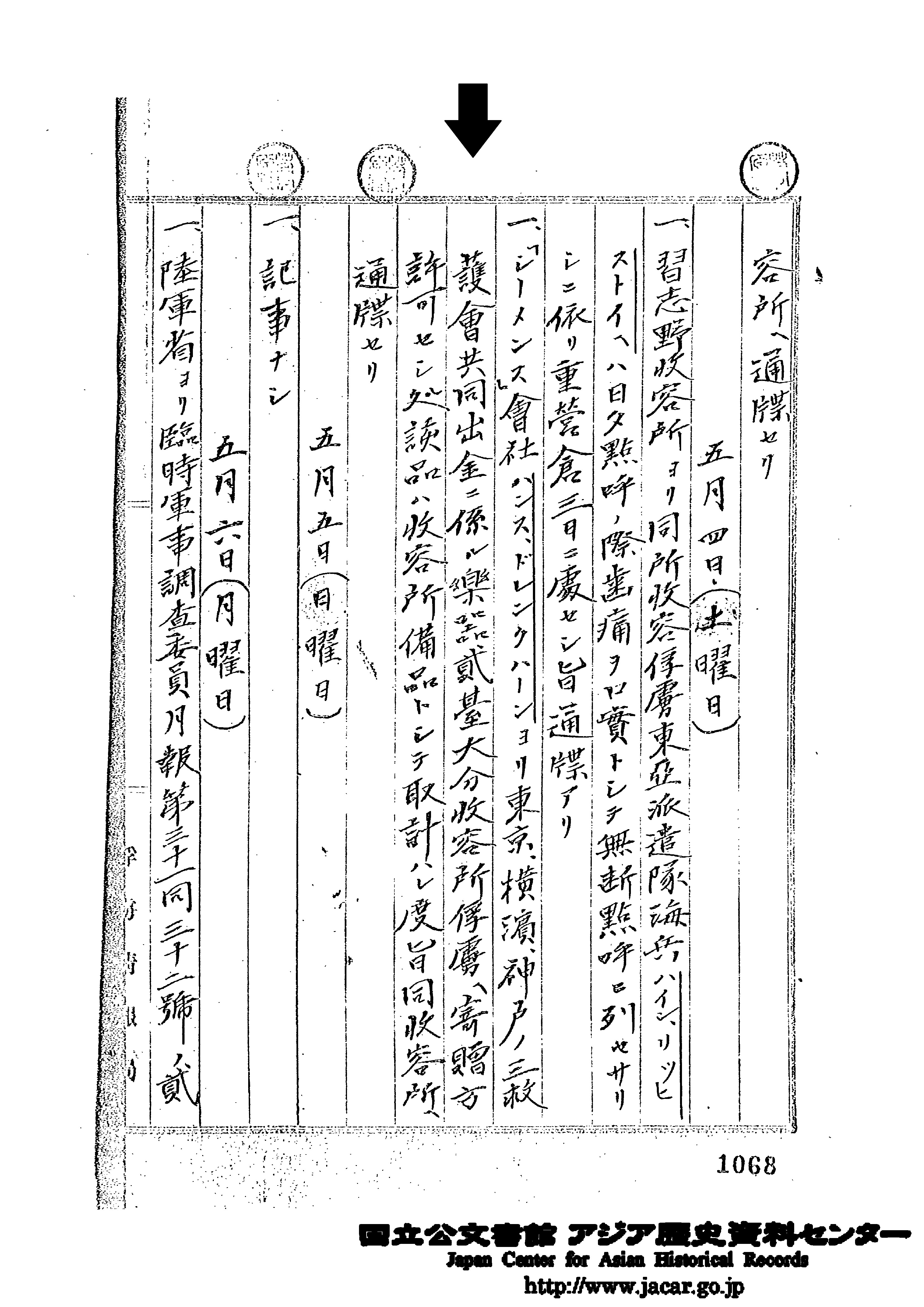
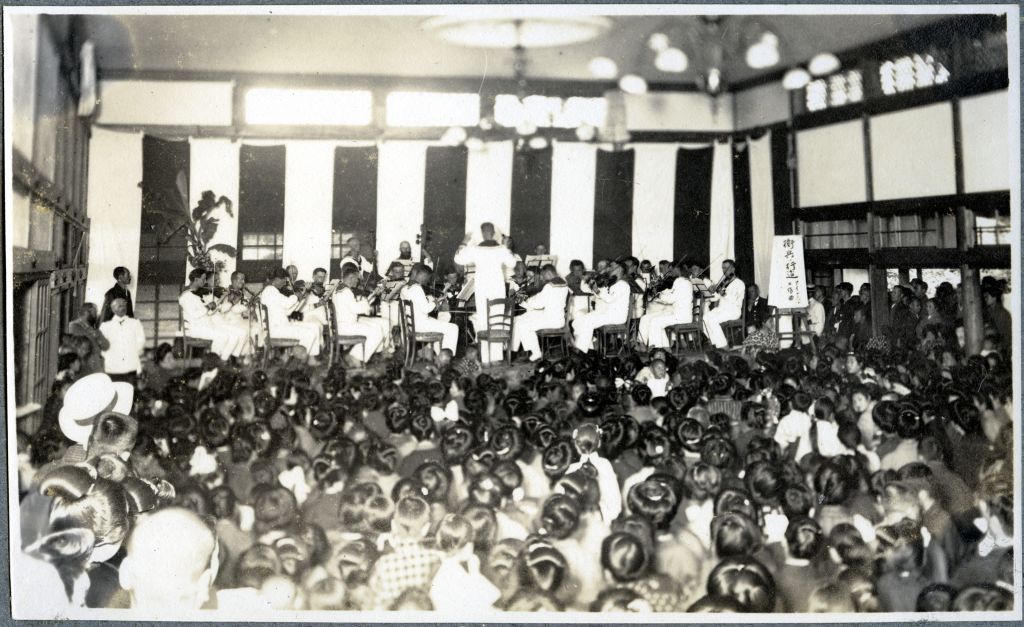
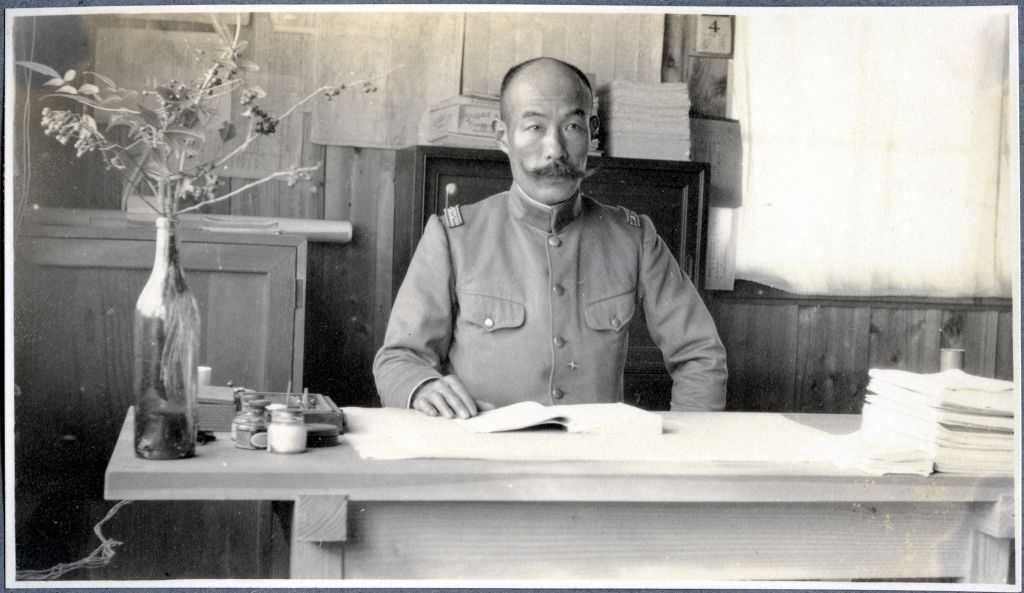
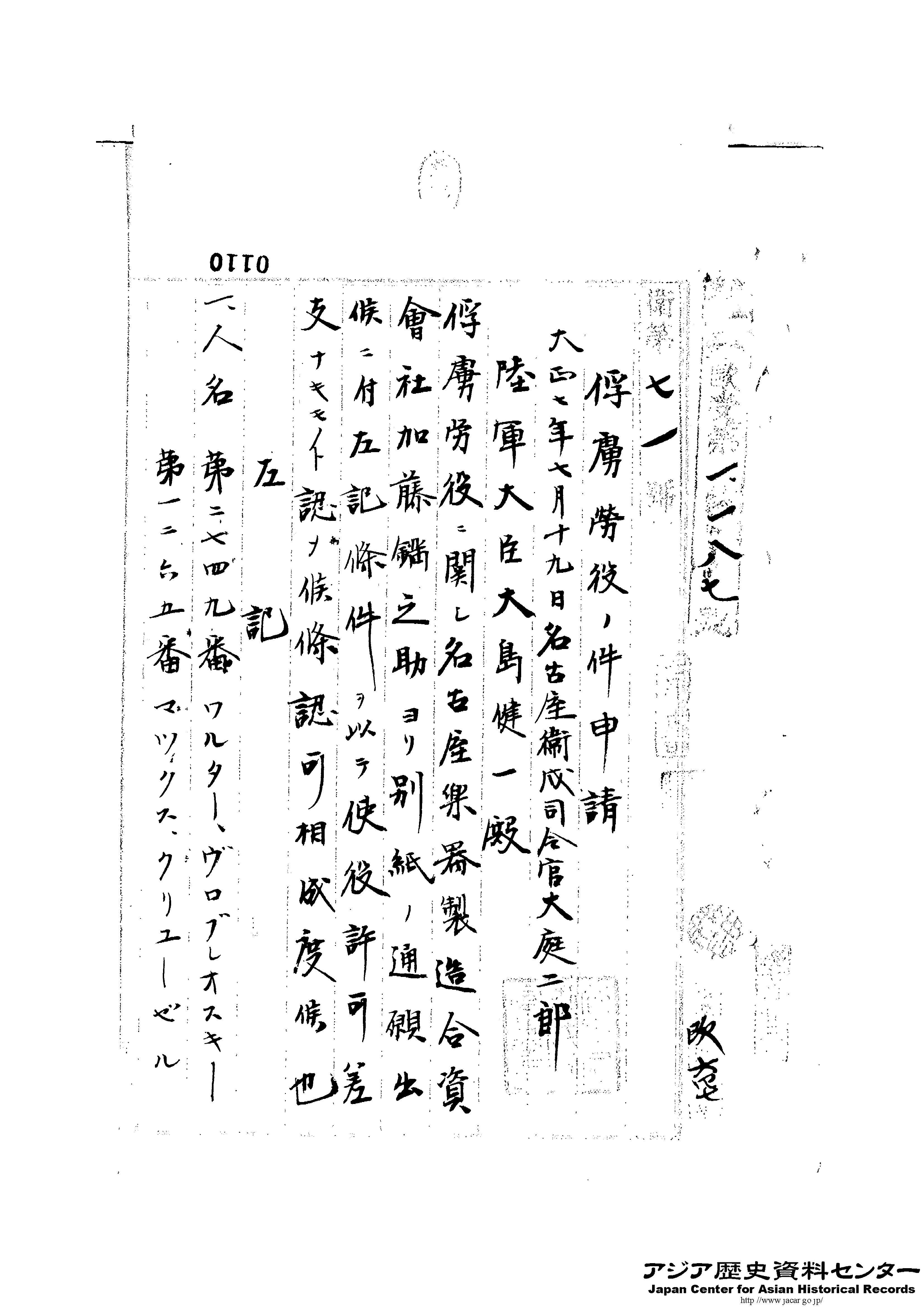
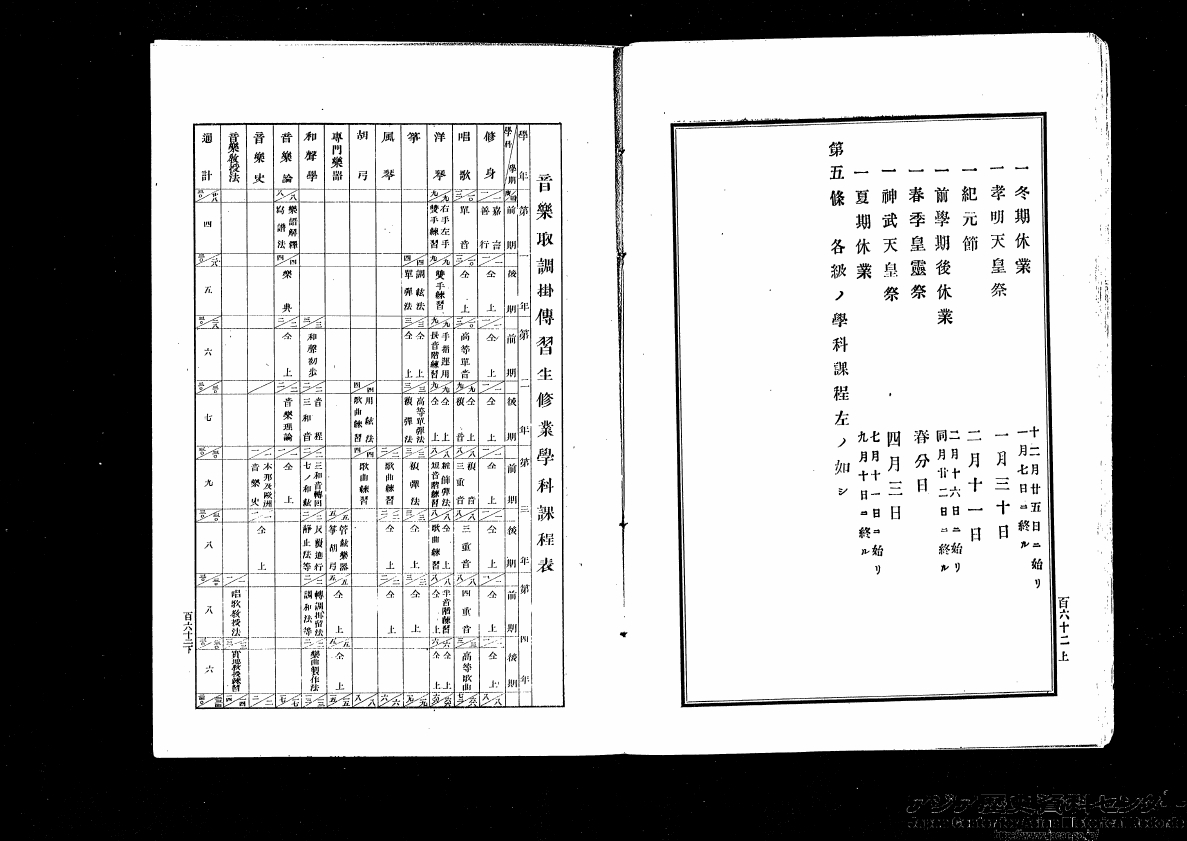
![FIGURE 2 Item name, “Ōshutsu-1418: Inquiry to the Army Ministry and [Navy Ministry] regarding Score Revisions,” Ref. C09102995100 (images 7 and 8)](img/026_content02-02_02.jpg)
